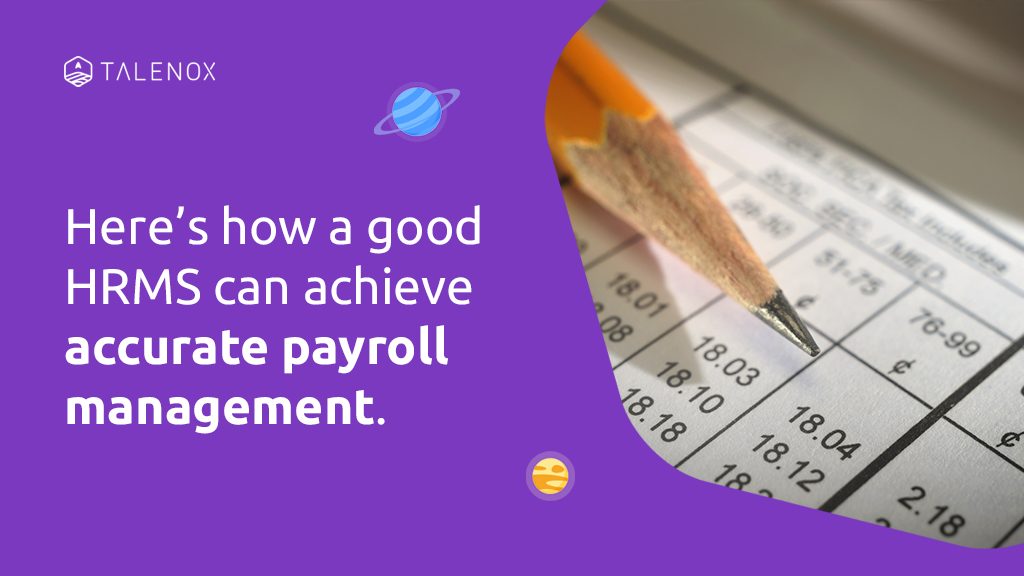Payroll management can be a complex and time-consuming task for businesses of all sizes. However, with the right human resource management system (HRMS), it is possible to achieve accurate and efficient payroll management. Here are some tips on how to achieve accurate payroll management with the right HRMS:
Choose an HRMS with robust payroll capabilities
Look for an HRMS that has built-in payroll functionality that can handle all of your payroll-related tasks, such as calculating taxes and deductions, issuing paychecks and direct deposit, and generating reports.
For example, Talenox has payroll features including payroll reporting, automatic calculations and automatic data entry. Automated data entry can help eliminate errors and save time by automating the process of entering employee information, calculating taxes and deductions, and issuing paychecks.
Integrate your HRMS with other software
Another way to achieve accurate payroll management is to integrate with other systems. If you’re a restaurant, you may want to integrate Talenox with your time attendance software to keep track of the working hours of part-time and full-time waiters.
If you’re part of an accounting firm, Talenox has a Xero integration which means easy setting up and integrating with your existing accounting system. This ensures a more seamless payroll process and that all your payroll transactions can be automatically recorded and reconciled in Xero. A good HRMS also integrates with any major accounting software since there are a large variety of accounting softwares to choose from. Many business classes often teach students to use either Xero or Quickbooks to do accounting for their small business
Ensure compliance
A good HRMS should help ensure compliance with local and laws regarding taxes and deductions. This is especially important in Singapore where the government is very strict with its law and breaking any, even by accident, can result in serious consequences.
A HRMS allows businesses to manage employee information, track attendance and leave, and calculate pay and deductions, all of which are essential for compliance with Singapore’s employment laws. The system can also assist in tracking statutory contributions such as the Central Provident Fund (CPF) and generating accurate reports for the Inland Revenue Authority of Singapore (IRAS). The HRMS also can be configured to automatically calculate and deduct income tax, ensuring compliance with the government regulations. The system can also alert the employer to any upcoming deadlines or changes in regulations, which can help to ensure timely compliance. Additionally, by automating data entry and calculations, the system can reduce the chances of human errors, which may cause non-compliance and legal issues.
Give employees the freedom to log in and view payslips themselves
In many small businesses, employees just receive small payslips which can often be lost or misplaced. Some employees don’t receive any payslips at all when the small business owner is too busy with all operating activities and forgets to issue them.
Offering self-service portals for employees to check their payslips and tax information helps to lower the workload of HR staff and the small business owner. This also increases transparency and trust. Allowing employees to view their own payslips and other payroll-related information gives them more visibility into the process and helps to build trust in the company they’re working in and the professional standard that it has.
It’s also convenient for employees to view their payslips in one place, from anywhere, at any time. This is far better than having to manually file away physical payslips, or search through your inbox for emails with payslips from the HR team. This can also be especially convenient for remote workers or employees who are frequently on the go.
In conclusion, a HRMS is important for every business because it allows for efficient management of employee information, tracking of attendance and leave, and calculation of pay and deductions. A HRMS can also assist in compliance with laws and regulations around employees, and automate repetitive tasks. It also can help to improve communication and engagement between employees and management.

Watch how Talenox makes payroll processing so easy!







Great blog. Thanks for sharing this Blog.
Exceptional read! Your guide on achieving accurate payroll management with the right HRMS is insightful. The step-by-step approach offers a clear roadmap. Truly valuable content for HR professionals!
Thank you! We’re really glad you find our article insightful.